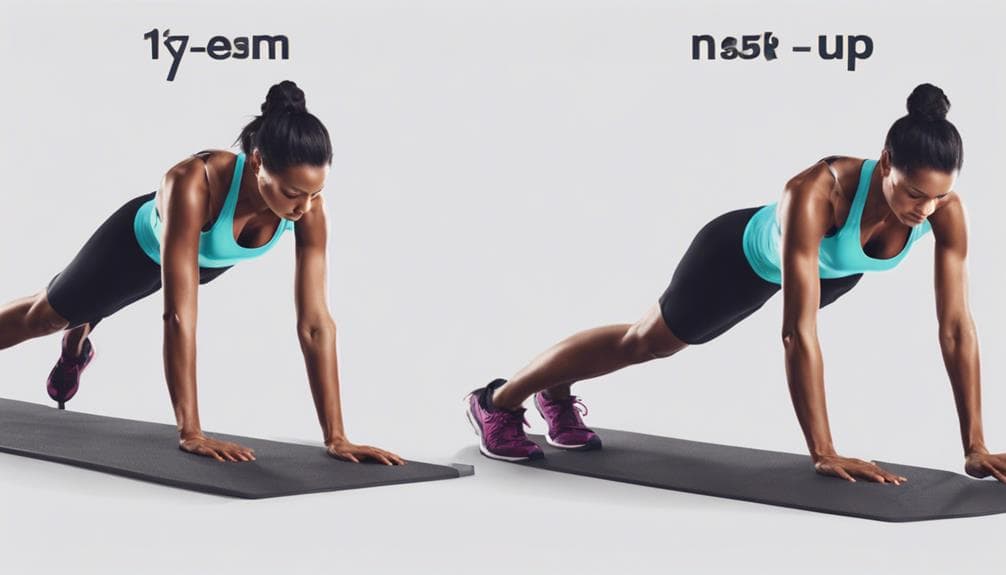On average, it's estimated that 2-3 knee push-ups equal 1 full push-up, making modified push-ups a great way to build upper body strength and endurance while reducing strain on your lower back and core. You'll engage your chest, shoulders, and triceps, and improve your cardiovascular fitness and core stability. By doing knee push-ups, you're not only building strength, but also preparing yourself to eventually tackle full push-ups. Take the first step towards achieving your fitness goals, and you'll be surprised at how much you can accomplish in no time.
Key Takeaways
• An estimated 2-3 knee push-ups are equivalent to 1 full push-up, although this conversion factor may vary based on individual strength levels.
• Knee push-ups engage the same muscle groups as full push-ups, including the chest, shoulders, and triceps, but with reduced intensity.
• The strength conversion factor is essential to understand when progressing from knee push-ups to full push-ups.
• Building upper body strength through knee push-ups can help prepare individuals for full push-ups by targeting key muscle groups.
• The 2-3:1 ratio serves as a general guideline, but individual variations may occur depending on factors like fitness level and technique.
Understanding Knee Push-Ups
When you adjust a traditional push-up by dropping to your knees, you're fundamentally creating a more accessible exercise that still targets your upper body strength, but with less strain on your lower back and core. This modified version, known as knee push-ups, is an excellent way to build strength and endurance without putting excessive pressure on your joints.
In a knee push-up, you'll bend your legs, allowing your knees to touch the ground, and form a straight line with your body. This modification reduces the difficulty of traditional push-ups, shifting the focus more onto your upper body strength and toning. While there isn't an exact conversion, it's estimated that 2-3 knee push-ups may equal 1 full push-up, depending on your individual fitness level.
Knee push-ups are an excellent option for beginners, serving as a stepping stone to full push-ups. By mastering proper form and gradually increasing your reps, you'll build strength and eventually progress to performing full push-ups.
Knee push-ups offer a more manageable and accessible way to work on your upper body, making them an ideal starting point for those looking to improve their fitness.
Benefits of Modified Push-Ups
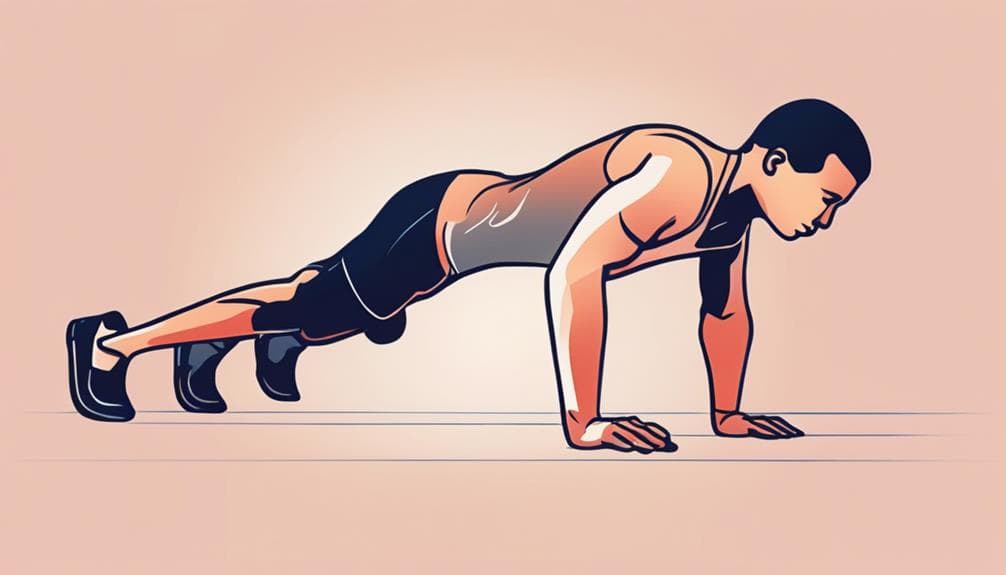
As you incorporate modified push-ups into your workout routine, you'll start to notice significant improvements in your upper body strength.
You'll also appreciate that knee push-ups are easier on your joints compared to traditional push-ups, reducing the risk of injury.
Improved Upper Body Strength
By incorporating knee push-ups into your workout routine, you'll effectively engage your chest, shoulders, and triceps, leading to significant improvements in upper body strength. This modified push-up variation is an excellent strength training exercise for those looking to build a stronger upper body.
As you perform knee push-ups, you'll notice increased muscle engagement and toning in your chest, shoulders, and triceps, ultimately leading to enhanced overall upper body strength.
Regular practice of knee push-ups will also contribute to improved cardiovascular fitness and contribute to overall upper body toning. Moreover, the muscle activation during knee push-ups is beneficial for developing core stability and increasing flexibility.
You can expect to see improvements in muscle engagement and toning with regular practice of knee push-ups. By incorporating knee push-ups into your strength training routine, you'll be well on your way to building a stronger, more toned upper body.
Easier on Joints
You'll appreciate that knee push-ups are a lower-impact alternative to traditional push-ups, which makes them an excellent option for individuals who need to minimize stress on their joints. This modification is particularly beneficial for those with joint issues or beginners who want to ease into strength training.
By switching to knee push-ups, you'll reduce the strain on your lower back and wrists, allowing you to focus more on building upper body strength without putting excessive pressure on your joints. This modified exercise is still effective in toning and strengthening your upper body muscles, making it an excellent introduction to full push-ups.
As you progress, you can gradually increase the intensity and work your way up to full push-ups. By incorporating knee push-ups into your workout routine, you'll be able to build the strength and endurance needed to take on more challenging exercises, ultimately leading you to achieve your fitness goals.
How to Perform Knee Push-Ups
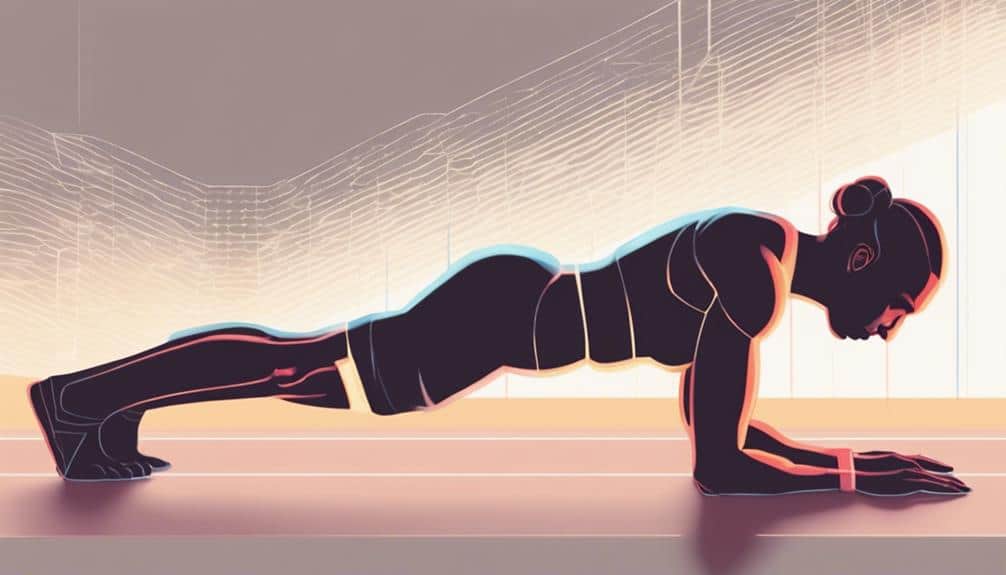
To get started with knee push-ups, position your hands shoulder-width apart on the ground, with your arms straight and your fingers spread wide. From this stance, bend your knees and place them on the ground, keeping your body in a straight line from head to heels. Engage your core and maintain a tight midsection to support your upper body.
Proper Form Checklist
| Body Part | Alignment | Engagement |
|---|---|---|
| Hands | Shoulder-width apart | Fingers spread wide |
| Knees | Bent, on the ground | Weight evenly distributed |
| Body | Straight line from head to heels | Core engaged, midsection tight |
As you lower your body, focus on using your upper body strength to control the movement. Keep your elbows close to your body and avoid letting your hips sag or your back arch. Push back up to the starting position, squeezing your chest and shoulder muscles at the top. Remember to maintain proper form throughout the exercise to target the right muscles and avoid injury.
Knee Push-Ups Vs Regular Push-Ups
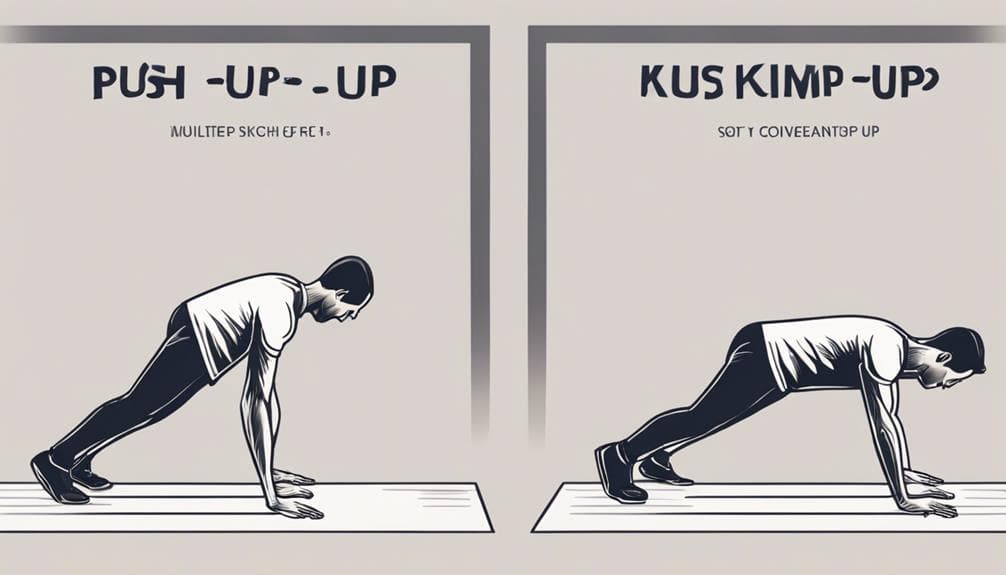
When you compare knee push-ups to regular push-ups, you'll notice key differences in muscle engagement, movement patterns, and intensity.
You'll engage different muscle groups, alter your movement patterns, and experience a reduced intensity workout with knee push-ups.
Now, let's break down these differences to understand how they impact your workout and progress towards mastering full push-ups.
Muscle Engagement Difference
While performing push-ups, your upper body muscles, including your chest, shoulders, and arms, are engaged similarly whether you're doing knee push-ups or regular push-ups. This means you're building strength in these areas regardless of which variation you choose.
The key difference lies in the lower body engagement. Knee push-ups take some pressure off your lower body, making them an excellent option for those who want to focus on upper body strength before advancing to regular push-ups.
In both variations, your core is engaged to maintain stability and proper form. This core engagement is essential for building overall strength and preventing injuries.
As you progress from knee push-ups to regular push-ups, you'll notice a gradual increase in strength and endurance in your upper body. This advancement is ideal for individuals who want to build strength incrementally.
Modified Movement Patterns
By modifying the movement pattern, knee push-ups noticeably reduce the overall difficulty of the exercise, making them an ideal stepping stone for those working up to regular push-ups. You'll find that knee push-ups are a great way to build strength and confidence before progressing to the full exercise.
Here's a comparison of knee push-ups and regular push-ups:
| Feature | Knee Push-Ups | Regular Push-Ups |
|---|---|---|
| Leg Position | Bent legs, knees on ground | Straight legs, toes on ground |
| Muscle Focus | Upper body (chest, shoulders, triceps) | Upper and lower body (legs, core engaged) |
| Difficulty | Easier, reduced strain on lower body | More challenging, engages entire body |
| Progression | Ideal for building up to regular push-ups | Ultimate goal for building upper body strength |
When you perform knee push-ups, you're primarily engaging your upper body muscles, with reduced strain on your lower body. This modified movement pattern allows you to focus on proper form and build strength before advancing to full push-ups. By mastering knee push-ups, you'll set yourself up for success when you're ready to take on the added challenge of regular push-ups.
Reduced Intensity Option
How do you determine the equivalent value of knee push-ups to regular push-ups, and what's the benefit of opting for this reduced intensity option?
When you choose knee push-ups over traditional push-ups, you're basically reducing the intensity of the exercise. This modified movement pattern is ideal for beginners or those who want to focus on upper body strength before progressing to traditional push-ups.
Knee push-ups are equivalent to regular push-ups, but with a lower intensity level. On average, 2-3 knee push-ups are equivalent to 1 full push-up, although this can vary based on individual fitness levels and form.
The reduced intensity of knee push-ups allows you to build strength and prepare your body for more challenging variations. What's more, maintaining proper form and engaging your core and upper body muscles is important for effective strength-building, even with knee push-ups.
The Strength Conversion Factor
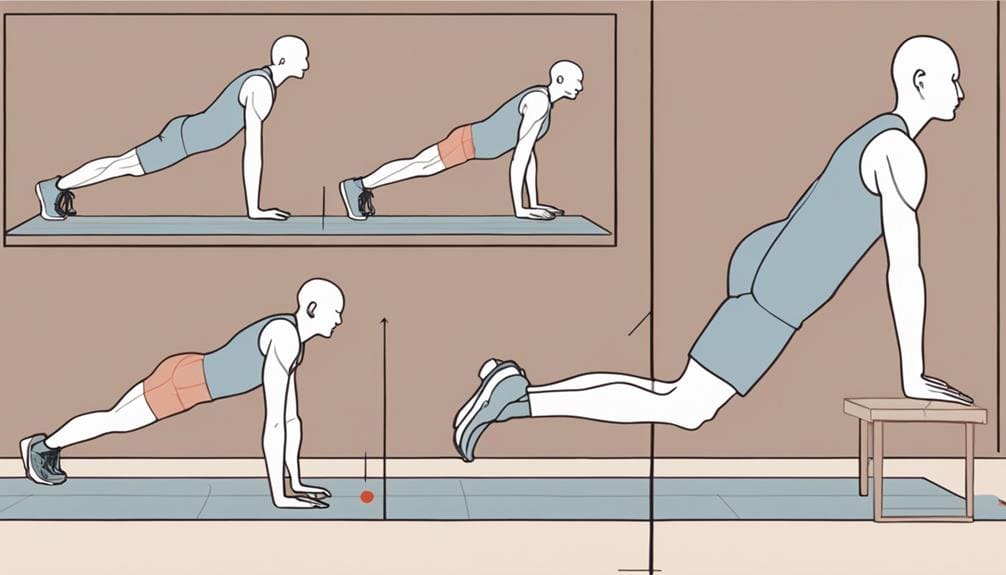
Estimating the strength conversion factor between knee push-ups and full push-ups is essential, as it allows you to set realistic goals and track your progress toward achieving a full push-up. On average, it's estimated that 2-3 knee push-ups are equivalent to 1 full push-up for most individuals. However, this shift factor may vary based on your individual strength levels and muscle engagement during the exercise.
When you perform knee push-ups, you're engaging your chest muscles, shoulders, and triceps, but to a lesser extent than a full push-up. As you progress, you'll need to build strength in these muscles to evolve to full push-ups.
By listening to your body's feedback and gradually increasing the number of knee push-ups, you can build the strength and technique needed for a full push-up. Remember, using knee push-ups as a stepping stone can help beginners develop the strength and technique needed for full push-ups.
Building Upper Body Strength
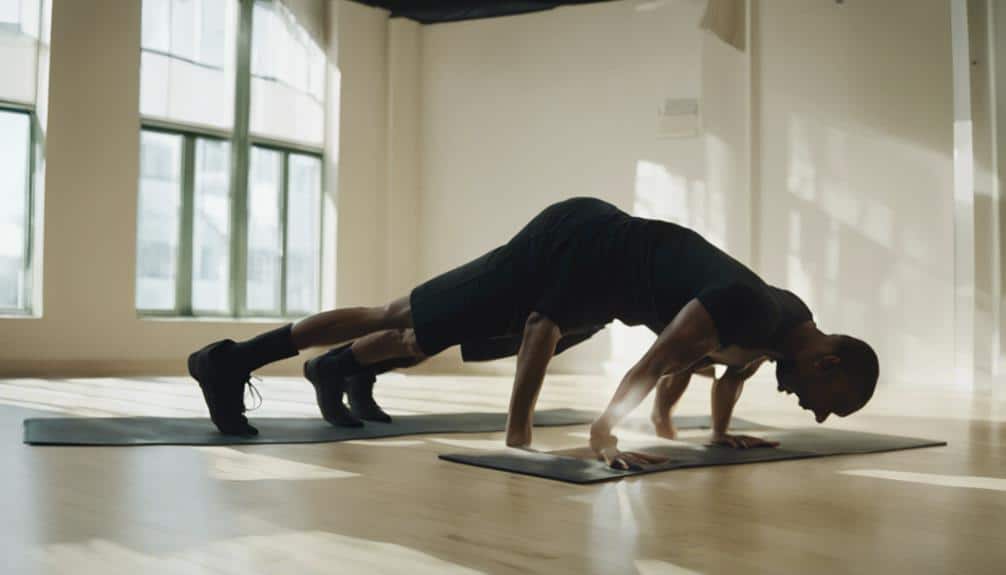
You'll build upper body strength progressively by shifting from knee push-ups to full push-ups, which targets multiple muscle groups simultaneously. This change is important, as it allows you to engage your core and glutes, preparing your body for the more challenging task of regular push-ups.
By perfecting your form in knee push-ups, you'll strengthen the necessary muscles to take on the full push-up challenge. Remember, knee push-ups are designed to be demanding, gradually increasing your strength and endurance for the ultimate goal of mastering full push-ups.
As you progress from knee push-ups to normal push-ups, you'll notice a significant improvement in your overall upper body strength. This is because full push-ups engage multiple muscle groups, including your chest, shoulders, and triceps, simultaneously.
Tips for Improving Form
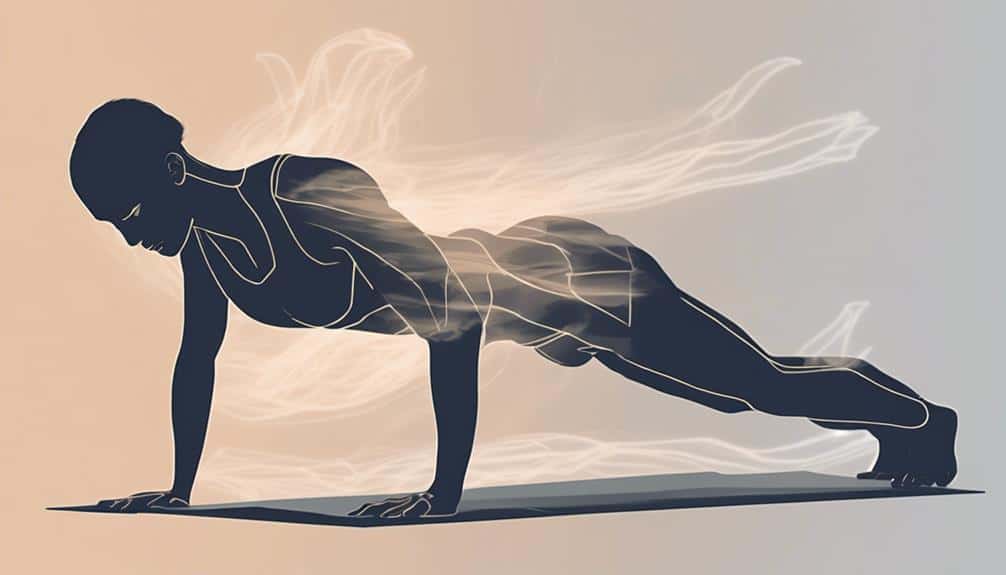
As you work on building upper body strength, remember that proper form is key.
To improve your knee push-up form, start by engaging your core muscles to support your back, placing your hands directly under your shoulders to prevent wrist strain, and maintaining a straight line from head to knees.
Engage Core Muscles
To maintain a strong, stable foundation for your knee push-ups, focus on engaging your core muscles, which act as a solid anchor for your body. As you lower yourself towards the ground, tighten your abdominal muscles to support your body weight. This will help you maintain a straight line from head to knees, ensuring proper form.
| Muscle Group | Action | Benefits |
|---|---|---|
| Abdominal muscles | Tighten and engage | Supports body weight, improves posture |
| Glutes | Contract and squeeze | Stabilizes body, generates power |
| Lower back | Engage and support | Maintains straight line, prevents strain |
Proper Hand Placement
Proper hand placement is the cornerstone of a successful knee push-up, as it sets the stage for a stable and efficient movement that engages your entire core and upper body. When you place your hands correctly, you'll be able to maintain alignment and distribute your weight evenly, which is essential for a smooth and effective movement.
To achieve proper hand placement, place your hands slightly wider than shoulder-width apart, directly under your shoulders. This guarantees that your weight is evenly distributed and prevents strain on your wrists and shoulders.
Spread your fingers out and keep your palms flat on the ground to support wrist stability. This will help you maintain a strong and stable foundation, allowing you to focus on engaging your core muscles and moving through the exercise with ease.
Body in Straight Line
You'll maintain a straight line from head to knees by engaging your core muscles and keeping your hands directly under your shoulders, ensuring a stable foundation for a controlled and effective knee push-up. This is vital for proper form, as it prevents your hips from sagging and allows you to focus on controlled movements. By doing so, you'll be able to achieve a full range of motion, which is essential for building strength and improving your overall fitness levels.
As you practice knee push-ups, remember that maintaining a straight line is essential. This will help you develop the strength and control you need to progress to full push-ups. Don't sacrifice form for quantity – focus on quality movements that engage your core and keep your body in a straight line. With consistent practice and attention to form, you'll be surprised at how quickly your strength and fitness levels improve.
Increasing Push-Up Endurance
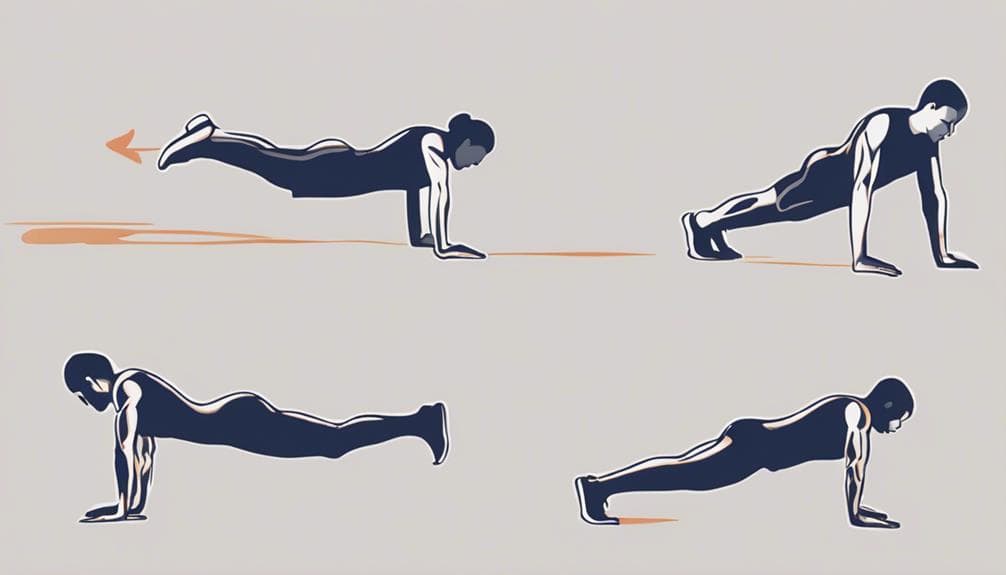
By gradually increasing your knee push-up reps, you can build the strength and endurance needed to tackle full push-ups with confidence. This progression is key to strengthen the muscles necessary for a successful shift.
As you consistently practice knee push-ups, you'll enhance muscle engagement and endurance, ultimately leading to improved push-up performance.
To take your push-up game to the next level, focus on:
- Gradual progression: Increase your knee push-up reps over time to build strength and endurance.
- Consistency is key: Regular practice of knee push-ups will help you develop the muscles needed for full push-ups.
- Listen to your body: Pay attention to your body's signals and only advance to full push-ups when you feel ready, avoiding injury or burnout.
Are Knee Push-Ups Effective?

As you incorporate knee push-ups into your workout routine, you'll likely wonder whether this modified exercise is truly effective in building upper body strength and setting you up for success with full push-ups. The answer is yes! Depending on individual fitness, knee push-ups can be a valuable addition to your workout routine.
These modified push-ups engage key muscles like the chest, shoulders, and triceps effectively, making them beneficial for beginners and those focusing on upper body strength. In fact, research supports knee push-ups as a valuable workout for building upper body strength and muscle toning.
Furthermore, knee push-ups serve as a stepping stone towards full push-ups, allowing you to gradually progress and build endurance. To maximize the effectiveness of knee push-ups, it's essential to maintain proper form and gradually advance your workout routine.
Myths and Misconceptions
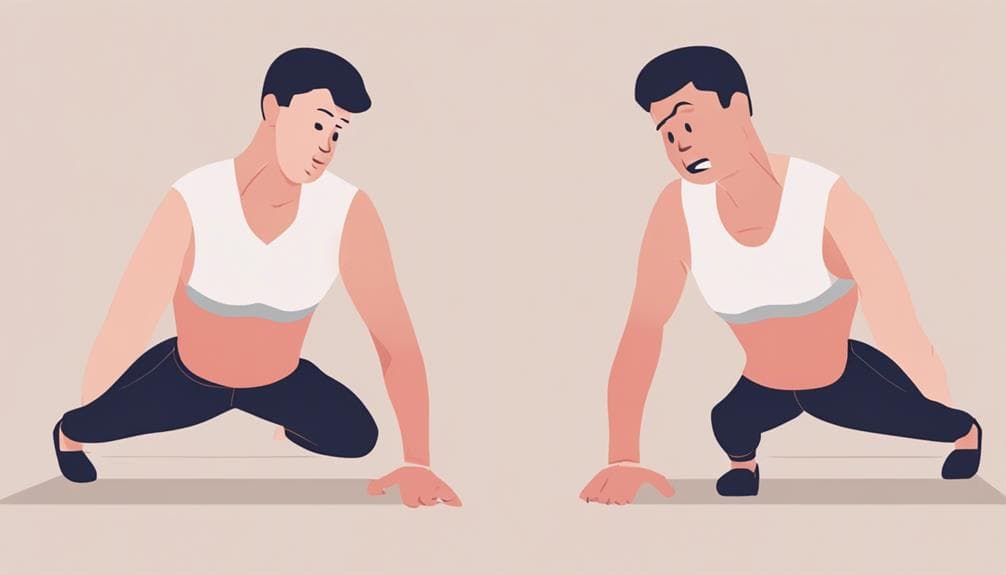
Now that you're convinced of the effectiveness of knee push-ups, it's crucial to debunk some common myths and misconceptions surrounding this exercise. As you progress in your fitness journey, it's vital to separate fact from fiction to get the most out of your workout.
Here are some common myths and misconceptions about knee push-ups:
- Myth-busting time!
Knee push-ups aren't always easy, and they can be just as challenging as full push-ups.
Knee push-ups aren't just for beginners; they can help build upper body strength.
Knee push-ups can be a stepping stone to mastering full push-ups, engaging key muscle groups like the chest, shoulders, and triceps.
Taking Your Fitness Further
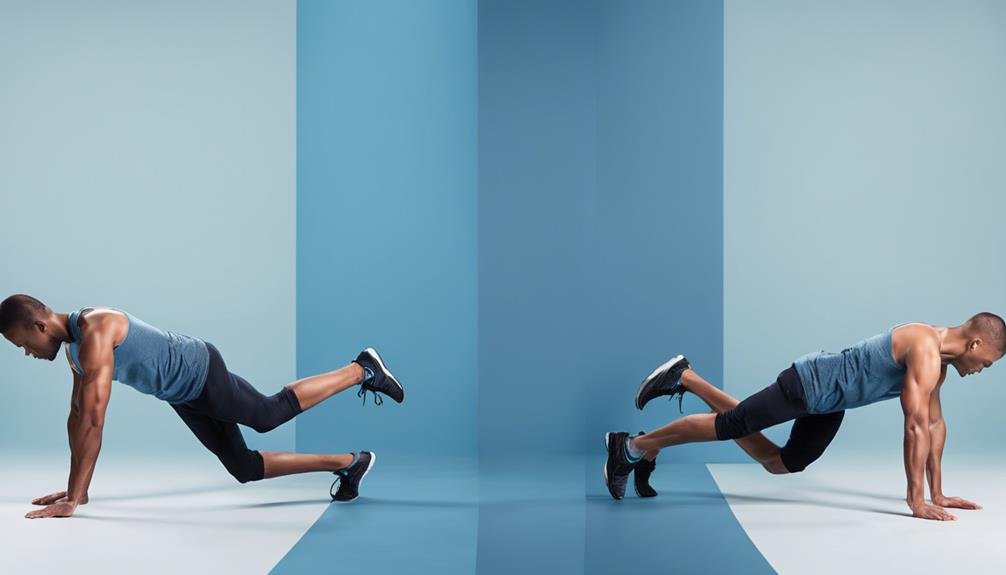
You're likely wondering how to take your fitness to the next level, and the good news is that progressing from knee push-ups to full push-ups is a journey that's both achievable and empowering. As an exercise for beginners, knee push-ups are an excellent way to build upper body strength, setting a strong foundation for mastering full push-ups. But how do you move forward? The key is gradual advancement, listening to your body, and focusing on proper form and progression.
| Knee Push-Ups | Full Push-Ups |
|---|---|
| 2-3 reps | 1 rep |
| Builds upper body strength | Increases overall strength |
| Modifies exercise for beginners | Challenges entire body |
| Prepares for full push-ups | Achieves full fitness potential |
Frequently Asked Questions
How Many Knee Push-Ups Is One Push-Up?
You're wondering how many knee push-ups equal one push-up, and the answer is, it's not an exact science. But here's the thing: it's not about the number, it's about your progress.
You're likely starting with knee push-ups to build strength and technique before advancing to full push-ups. Focus on gradually increasing your knee push-ups, and when you're ready, you'll naturally shift to full push-ups.
Aim to do 2-3 knee push-ups for every 1 full push-up, but remember, it's your fitness journey that matters, not the exact count.
What Is 1 Push-Up Equivalent To?
You're wondering what 1 push-up is equivalent to? Essentially, it's about building strength and mastering proper form.
Think of it this way: 1 push-up is equal to a strong, controlled movement that engages your entire body. It's a reflection of your hard work and dedication to fitness.
Are Knee Push-Ups as Effective?
You're wondering if knee push-ups are as effective as the real deal.
The answer is, absolutely!
Knee push-ups engage similar muscle groups as regular push-ups, making them a valuable workout option.
By doing knee push-ups, you're still toning and developing your upper body muscles, even if it's not as intense as a full push-up.
What Counts as 1 Pushup?
You're wondering what counts as one push-up, right? Let's get to the bottom of it!
The truth is, a push-up isn't just about lowering your body until your chest almost touches the ground. It's about proper form, engaging your core, and using your entire body to lift yourself back up.
